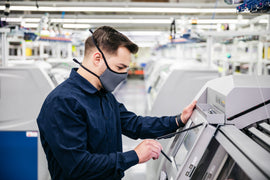
A blog brought to you by the Myant Health Team.
As we age, our lives and social connections start to change. Children grow up, move out, and may move far away. As children and younger relatives get older, they often get busier with their own work and life commitments.¹ Some of us may think about retiring from work and moving on to new challenges. Older adults are more likely to move from their homes or experience loss, including the loss of a significant other and it may be tough for them to make friends in new environments like retirement homes. With all these life changes, we may lose our sense of connection to others without even noticing. Loss of connection due to life events can lead to loneliness as well.²
As our lives become busier our reliance on technology continues to increase. Family dinners involve more screen time than conversations with our loved ones. On Friday nights we’re more likely to watch movies alone on our devices than crowding on the couch fighting over the TV remote. Being “alone-together” is incredibly common.³
Did you know that fewer and less frequent social connections can have a negative effect on mental wellbeing and physical health?

Social connectedness, which is the quality or depth of the connection you have with other people, rather than the number of connections, can reduce feelings of loneliness and the effects of social isolation.⁶
Connecting through technology also allows you to begin to connect with and understand yourself more7. It allows you and your loved ones to connect and understand each other on a deeper level. Technology can also help to improve feelings of connection over distance if a loved one is far away.⁷ ⁸
With a goal of enabling human connection through technology, Myant Health has designed and developed smart textiles by utilizing conductive yarns and knitting sensors and electrodes into everyday garments. Recently, Myant launched Skiin™—a line of wearable smart garments that can sense and react to the human body.
As the user wears their Skiin garment and goes about their day, sensors woven into the fabric collect the user’s biometric health data and store it in the Skiin Pod. This data—such as heart rate, body temperature, posture, steps, activity, and location is pushed to the cloud and then can be viewed in the Skiin Connected Life App and shared with the user’s care circle—including family, loved ones, and healthcare providers. Skiin is classified as a medical device and is licensed by Health Canada.⁹ The biometric data collected, such as ECG from the Skiin Chest Band closely mimics that of a traditional 3-lead Holter monitor and can be made accessible to a cardiologist for further review.
New feature sets coming to Skiin include the ability to track sleep, respiration rate, resting heart rate (RHR), and heart rate variability (HRV). In addition, Skiin will have the ability to integrate data from third party devices such as a home blood pressure machine, finger sensor (SpO2), and home weight scale.
Skiin empowers you and your loved ones to better support each other on your healthcare journeys. It enables you to monitor your family’s wellbeing at any given moment and gives you the tools to discuss each other’s care plans with health care practitioners. Use Skiin to support and guide your choices and to give you ideas on how you can interact with and support your loved ones’ care. Even when you can’t be there physically, Skiin enables you to know how your family is doing at any time.
Learn more about Myant Health and Skiin at myanthealth.com.
References:
- Cornwell EW & Waite LJ. (2009). Social disconnectedness, perceived isolation, and health among older adults. Journal of Health and Social Behavior, 50, 31–48.doi.org/10.1177/002214650905000103
- Perissinotto CM, Stijacic Cenzer I, Covinsky KE. (2012). Loneliness in older persons: A predictor of functional decline and death. Archives of Internal Medicine, 172, 1078-1084.
- Turkle S. Alone together: Why we expect more from technology and less from each other. Hachette UK; 2017 Nov 7.
- McHugh JE, Lawlor BA. Perceived stress mediates the relationship between emotional loneliness and sleep quality over time in older adults. British journal of health psychology. 2013 Sep;18(3):546-55.
- Cacioppo JT, Cacioppo S. (2014). Social relationships and health: The toxic effects of perceived social isolation. Social and Personality Psychology Compass, 8, 58–72.10.1111/spc3.12087
- Barbosa Neves B, Franz R, Judges R, Beermann C, Baecker R. Can Digital Technology Enhance Social Connectedness Among Older Adults? A Feasibility Study. Journal of Applied Gerontology. 2019;38(1):49-72. doi:10.1177/0733464817741369
- Liddle J, Stuart A, Worthy P, Levine M, Kastelle T, Wiles J, et al. “Building the threads of connection that we already have”: The nature of connections via technology for older people. Clinical Gerontologist: The Journal of Aging and Mental Health 2020 Dec 03.
- McCausland L, Falk NL. (2012). From dinner table to digital tablet: Technology's potential for reducing loneliness in older adults. Journal of Psychosocial Nursing and Mental Health Services, 50(5), 22–26.10.3928/02793695-20120410-01
- Skiin Undergarment products are trademarked and Health Canada licensed under the medical device group family name "Skiin Underwear”




